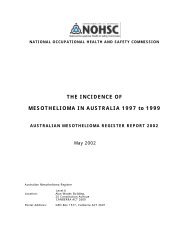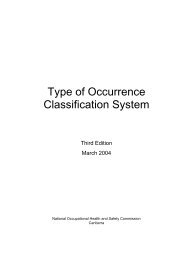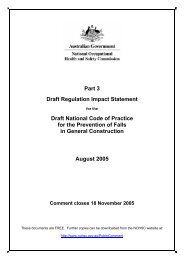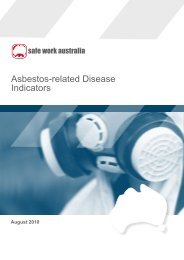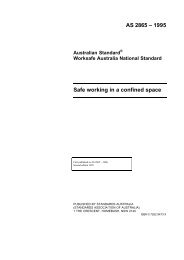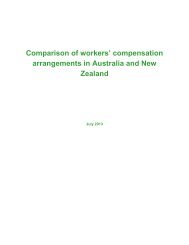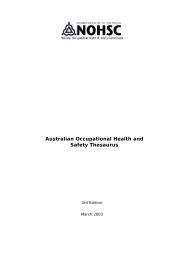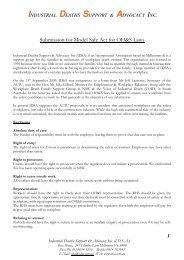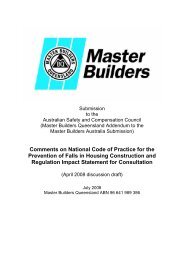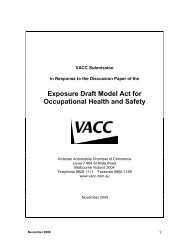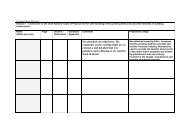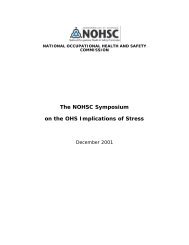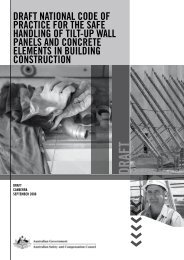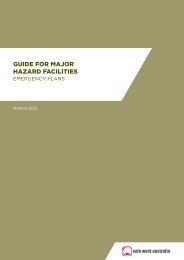Australian Mesothelioma Register Report 2004 - Safe Work Australia
Australian Mesothelioma Register Report 2004 - Safe Work Australia
Australian Mesothelioma Register Report 2004 - Safe Work Australia
You also want an ePaper? Increase the reach of your titles
YUMPU automatically turns print PDFs into web optimized ePapers that Google loves.
NOHSC DATA<br />
AUSTRALIAN MESOTHELIOMA REGISTER REPORT <strong>2004</strong><br />
THE INCIDENCE OF MESOTHELIOMA<br />
IN AUSTRALIA 1999 TO 2001<br />
<strong><strong>Australia</strong>n</strong><br />
<strong>Mesothelioma</strong><br />
<strong>Register</strong> <strong>Report</strong><br />
<strong>2004</strong><br />
November <strong>2004</strong>
NATIONAL OCCUPATIONAL HEALTH AND SAFETY COMMISSION<br />
THE INCIDENCE OF<br />
MESOTHELIOMA IN AUSTRALIA 1999 to 2001<br />
AUSTRALIAN MESOTHELIOMA REGISTER REPORT <strong>2004</strong><br />
<strong><strong>Australia</strong>n</strong> <strong>Mesothelioma</strong> <strong>Register</strong><br />
Location:<br />
Level 6, Alan Woods Building,<br />
25 Constitution Avenue<br />
CANBERRA ACT 2600<br />
Postal Address: GPO Box 1577, Canberra ACT 2601<br />
November <strong>2004</strong>
© Commonwealth of <strong>Australia</strong> <strong>2004</strong><br />
ISBN 1 920763 71 6 (print)<br />
ISBN 1 920763 70 8 (online)<br />
This work is copyright. Apart from any use as permitted under the Copyright Act 1968, no part may<br />
be reproduced by any process without prior written permission from the Commonwealth available<br />
from the Department of Communications, Information Technology and the Arts. Requests and<br />
inquiries concerning reproduction and rights should be addressed to the Commonwealth Copyright<br />
Administration, Intellectual Property Branch, Department of Communications, Information<br />
Technology and the Arts, GPO Box 2154, Canberra ACT 2601 or posted at<br />
http://www.dcita.gov.au/cca.<br />
The suggested citation is: The Incidence of <strong>Mesothelioma</strong> in <strong>Australia</strong> 1999 to 2001 –<br />
AUSTRALIAN MESOTHELIOMA REGISTER REPORT <strong>2004</strong>. National Occupational Health and<br />
<strong>Safe</strong>ty Commission: November <strong>2004</strong>.<br />
ii
CONTENTS<br />
SUMMARY ...................................................................................................................................................... 1<br />
INTRODUCTION............................................................................................................................................. 3<br />
ASBESTOS PRODUCTION AND USE IN AUSTRALIA.............................................................................. 3<br />
THE AUSTRALIAN MESOTHELIOMA PROGRAM AND REGISTER...................................................... 4<br />
STATISTICS..................................................................................................................................................... 5<br />
Table 1: Male cases of mesothelioma in <strong>Australia</strong>, 1999 by age and jurisdiction......................................... 6<br />
Table 2: Female cases of mesothelioma in <strong>Australia</strong>, 1999 by age and jurisdiction ..................................... 6<br />
Table 3:<br />
Table 4:<br />
Age-specific incidence rates for mesothelioma per million males in <strong>Australia</strong>, 1999 by<br />
age and jurisdiction.......................................................................................................................... 7<br />
Age-specific incidence rates for mesothelioma per million females in <strong>Australia</strong>, 1999 by<br />
age and jurisdiction.......................................................................................................................... 7<br />
Table 5: Male cases of mesothelioma in <strong>Australia</strong>, 2000 by age and jurisdiction......................................... 8<br />
Table 6: Female cases of mesothelioma in <strong>Australia</strong>, 2000 by age and jurisdiction ..................................... 8<br />
Table 7:<br />
Table 8:<br />
Age-specific incidence rates for mesothelioma per million males in <strong>Australia</strong>, 2000 by<br />
age and jurisdiction.......................................................................................................................... 9<br />
Age-specific incidence rates for mesothelioma per million females in <strong>Australia</strong>, 2000 by<br />
age and jurisdiction.......................................................................................................................... 9<br />
Table 9: Male cases of mesothelioma in <strong>Australia</strong>, 2001 by age and jurisdiction....................................... 10<br />
Table 10: Female cases of mesothelioma in <strong>Australia</strong>, 2001 by age and jurisdiction ................................... 10<br />
Table 11: Age-specific incidence rates for mesothelioma per million males in <strong>Australia</strong>, 2001 by<br />
age and jurisdiction........................................................................................................................ 11<br />
Table 12: Age-specific incidence rates for mesothelioma per million females in <strong>Australia</strong>, 2001 by<br />
age and jurisdiction........................................................................................................................ 11<br />
Table 13: Number of mesothelioma cases in <strong>Australia</strong>, by gender, notified to the <strong><strong>Australia</strong>n</strong><br />
<strong>Mesothelioma</strong> <strong>Register</strong> (NOHSC) and the National Cancer Statistics Clearing House of<br />
the <strong><strong>Australia</strong>n</strong> Institute of Health and Welfare (AIHW), 1986-2000 ............................................ 12<br />
Table 14: Number of mesothelioma cases in <strong>Australia</strong>, by jurisdiction, notified to the <strong><strong>Australia</strong>n</strong><br />
<strong>Mesothelioma</strong> <strong>Register</strong> (NOHSC) and the National Cancer Statistics Clearing House of<br />
the <strong><strong>Australia</strong>n</strong> Institute of Health and Welfare (AIHW), 1986-2000 ............................................ 13<br />
Table 15: Number of mesothelioma cases associated with a past asbestos exposure and industry<br />
(level 1) in <strong>Australia</strong>, 1999-2001................................................................................................... 14<br />
Table 16: Number of mesothelioma cases associated with a past asbestos exposure and industry<br />
(level 2) in <strong>Australia</strong>, 1999-2001................................................................................................... 15<br />
iii
Table 17: Number of work-related mesothelioma cases and industry (level 1) in <strong>Australia</strong>, 1999-<br />
2001............................................................................................................................................... 17<br />
Table 18: Number of work-related mesothelioma cases and industry (level 2) in <strong>Australia</strong>, 1999-<br />
2001............................................................................................................................................... 18<br />
Table 18: Number of work-related mesothelioma cases and industry (level 2) in <strong>Australia</strong>, 1999-<br />
2001 (continued)............................................................................................................................ 19<br />
Table 19: Number of mesothelioma cases associated with a past asbestos exposure and occupation<br />
(level 1) in <strong>Australia</strong>, 1999-2001................................................................................................... 20<br />
Table 20: Number of mesothelioma cases associated with a past asbestos exposure and occupation<br />
(level 2) in <strong>Australia</strong>, 1998-2000................................................................................................... 21<br />
Table 21: Number of work-related mesothelioma cases and occupation (level 1) in <strong>Australia</strong>,<br />
1999-2001...................................................................................................................................... 22<br />
Table 22: Number of work-related mesothelioma cases and occupation (level 2) in <strong>Australia</strong>,<br />
1999-2001...................................................................................................................................... 23<br />
Table 23: Number of mesothelioma cases classified by industry (level 1) and occupation (level 1)<br />
in <strong>Australia</strong>, 1999-2001................................................................................................................. 24<br />
Table 24: <strong>Mesothelioma</strong> cases by work-relatedness and asbestos exposure in <strong>Australia</strong>, 1998-<br />
2000. Number and per cent. ......................................................................................................... 25<br />
Figure 1: Incident cases of malignant mesothelioma, <strong>Australia</strong>, 1986-2001................................................... 26<br />
Figure 2: Age-specific incidence rates of malignant mesothelioma in <strong><strong>Australia</strong>n</strong> men, 1986-2001............... 26<br />
Figure 3: Age-specific incidence rates of malignant mesothelioma in <strong><strong>Australia</strong>n</strong> women, 1986-2001 .......... 27<br />
Figure 4: Cases of mesothelioma in <strong>Australia</strong>, 1998-2001, by site of primary lesion..................................... 27<br />
Figure 5: Trends in <strong><strong>Australia</strong>n</strong> incidence of mesothelioma per million persons, by jurisdiction,<br />
1982-2001...................................................................................................................................... 28<br />
Figure 6: Trends in <strong><strong>Australia</strong>n</strong> incidence of mesothelioma per million persons, by sex, 1982-2001 ............. 28<br />
APPENDIX A: <strong>Register</strong> Notification Form .................................................................................................... 29<br />
LIST OF PUBLICATIONS FROM THE MESOTHELIOMA PROGRAM AND REGISTER..................... 30<br />
iv
SUMMARY<br />
This publication is the sixteenth report of the <strong><strong>Australia</strong>n</strong> <strong>Mesothelioma</strong> <strong>Register</strong> (the <strong>Register</strong>),<br />
produced by the National Data Team of the National Occupational Health and <strong>Safe</strong>ty Commission<br />
(NOHSC). <strong>Mesothelioma</strong> is a fatal form of cancer usually with a very long period between<br />
exposure and diagnosis.<br />
Long-term data from the <strong>Register</strong>, excluding the last two years that are likely to underestimate the<br />
true number of mesothelioma cases due to underreporting to the <strong>Register</strong>, indicates that:<br />
(a) the incidence rates of malignant mesothelioma have been increasing in <strong>Australia</strong> since 1965.<br />
It is believed that these high rates of mesothelioma are related to the extensive use and<br />
production of asbestos in <strong>Australia</strong> in previous decades;<br />
(b) mesothelioma incidence rates are higher in males than females, possibly because of a higher<br />
exposure in male-dominated industries that produced or used asbestos (e.g. construction and<br />
manufacturing);<br />
(c) the 50-64, 65-79 and 80 plus age groups have the highest age-specific incidences of<br />
mesothelioma;<br />
(d) year-to-year fluctuations in age-specific mesothelioma cases are lower in persons older than<br />
64 years than in younger persons on account of the former having large numbers; and<br />
(e) most <strong><strong>Australia</strong>n</strong> mesothelioma cases are cancerous lesions of the pleura. <strong>Mesothelioma</strong><br />
cases affecting the peritoneum and other sites are fewer.<br />
Based on the malignant mesothelioma cases recorded from 1999 to 2001, long-term data from the<br />
<strong>Register</strong>, and comparison data from the National Cancer Statistics Clearing House of the <strong><strong>Australia</strong>n</strong><br />
Institute of Health and Welfare (AIHW) (see Tables 13 and 14):<br />
a) from 1986 to 2000, The <strong>Register</strong> had 3.4% fewer notifications of new cases of malignant<br />
mesothelioma than did the AIHW National Cancer Statistics Clearing House;<br />
b) the percentage difference between the <strong>Register</strong> and the AIHW ranged from 8.7% fewer<br />
cases in the <strong>Register</strong> (for Victoria) to 7.0% more cases in the <strong>Register</strong> (for Tasmania);<br />
c) a number of jurisdictions (most notably Victoria, New South Wales and, to a lesser extent,<br />
South <strong>Australia</strong> and Queensland) have probably underreported cases from cancer registries<br />
to the <strong>Mesothelioma</strong> <strong>Register</strong> from 1999 onwards. Therefore, figures reported to the<br />
<strong>Register</strong> for this period are likely to underestimate the true number of mesothelioma deaths;<br />
d) the <strong>Register</strong> is often notified of some backlog cases whose year of diagnosis occurred<br />
previous to the year of notification. When this happens, the number of notified cases in that<br />
notification year are inflated;<br />
e) there is no firm indication of when the incidence rates of mesothelioma will start to decline<br />
in <strong>Australia</strong>;<br />
f) incidence rates of malignant mesothelioma continue to be the highest in males; and<br />
g) Western <strong>Australia</strong> consistently, and South <strong>Australia</strong> inconsistently, have incidence rates<br />
above the national average. Queensland incidence rates are at or above the national average,<br />
while New South Wales rates are near the national average of 42-61 cases per million males.<br />
Rates for the <strong><strong>Australia</strong>n</strong> Capital Territory, Northern Territory and Tasmania are imprecise<br />
because they are based on low numbers, but the true underlying rates are likely to be well<br />
below the national average.<br />
Since 1986 the <strong>Register</strong> has received 6,630 notifications of mesothelioma. Past employment history<br />
recorded as text on the mesothelioma case notification forms received by the <strong>Register</strong> from 1999 to<br />
2001 was used to study occupational exposure to asbestos, given industry and occupation, with the<br />
view to improve efficiency in monitoring mesothelioma. The ANZSIC (ABS 1993) and ASCO<br />
(ABS 1997) coding systems were used to code for industry and occupation, respectively. Some deidentified<br />
cases were notified to the <strong>Register</strong> in 2002 from Victoria. These cases could not be coded<br />
1
for occupation and industry owing to lack of information on past employment. The remaining 1,201<br />
cases notified to the <strong>Register</strong> from 1999 to 2001 were categorised as follows (see Tables 15 to 24):<br />
(a) about 50% of the cases were uncodeable for industry and occupation;<br />
(b) about 50% of the cases were uncodeable for occupational asbestos exposure and workrelatedness;<br />
(c) of the persons reported to have been exposed to asbestos, 29% worked in the Construction<br />
industry, 28% worked in the Manufacturing industry, 46% had a Tradespersons and related<br />
workers occupation and 16% had a Labourers and related workers occupation;<br />
(d) of the mesothelioma cases with a past asbestos exposure, 87% were considered workrelated,<br />
4% were not work-related and the rest (9%) could not be classified;<br />
(e) of the mesothelioma cases that were considered to be work-related, 82% had a past asbestos<br />
exposure, 2% possibly had a past asbestos exposure, 3% had no known asbestos exposure<br />
and the rest (13%) could not be classified; and<br />
(f) of the persons with work-related mesothelioma, 32% worked in the Construction industry,<br />
31% worked in the Manufacturing industry, 49% had a Tradespersons/Related workers<br />
occupation, 16% had a Labourers/Related workers occupation, and 15% had an<br />
Intermediate Production/Transport workers occupation.<br />
2
INTRODUCTION<br />
This document is the sixteenth report of the <strong><strong>Australia</strong>n</strong> <strong>Mesothelioma</strong> <strong>Register</strong>, produced by the<br />
National Data Team of the National Occupational Health and <strong>Safe</strong>ty Commission (NOHSC).<br />
Malignant mesothelioma is a cancer of the outer covering of the lung (the pleura) or the abdominal<br />
cavity (the peritoneum). Formerly rare, it is increasing in incidence throughout the industrial world<br />
and is very frequently associated with past exposure to asbestos. It is usually fatal and has no direct<br />
relation to smoking. <strong>Australia</strong> has the world’s highest incidence rate (Takahashi et al, 1999;<br />
Tossavainen and Takahashi, 2000).<br />
ASBESTOS PRODUCTION AND USE IN AUSTRALIA<br />
In <strong>Australia</strong>, more chrysotile than amphibole asbestos was mined until 1939. With the<br />
commencement of mining at Wittenoom, Western <strong>Australia</strong> in 1937, crocidolite dominated<br />
production, until final closure in 1966. New South Wales, the first State to mine asbestos, also<br />
produced the largest tonnages of chrysotile (until 1983) as well as smaller quantities of amphibole<br />
(until 1949). With the closing of the crocidolite mine at Wittenoom, <strong><strong>Australia</strong>n</strong> asbestos production<br />
and exports declined. Imports of chrysotile also started to decline. The main sources of raw asbestos<br />
imports were from Canada (chrysotile) and South Africa (crocidolite and amosite). Consumption<br />
peaked in about 1975 at 70,000 tonnes/year.<br />
In addition to imports of asbestos fibre, <strong>Australia</strong> also imported many manufactured asbestos<br />
products, including asbestos cement articles, asbestos yarn, cord and fabric, asbestos joint and<br />
millboard, asbestos friction materials and gaskets. The main sources of supply were the United<br />
Kingdom, USA, Federal Republic of Germany and Japan. In <strong>Australia</strong>, over 60% of all production<br />
and 90% of all consumption of asbestos fibre was used by the asbestos cement manufacturing<br />
industry. From about 1940 to the late 1960s all three types of asbestos were used in this industry.<br />
The use of crocidolite began being phased out from 1967. Amosite was used until the mid 1980s.<br />
Much of this industry output remains in service today in the form of “fibro” houses and water and<br />
sewerage piping. By 1954 <strong>Australia</strong> was number four in the Western world in gross consumption of<br />
asbestos cement products, after the USA, UK and France, and clearly first on a per capita basis.<br />
After World War II to 1954, 70,000 asbestos cement houses were built in the State of New South<br />
Wales alone (52% of all houses built). In <strong>Australia</strong> as a whole, until the 1960s, 25% of all new<br />
housing was clad in asbestos cement.<br />
Exposures in the past were very high in some industries and jobs - (eg, 25 million particles per<br />
cubic foot (150 fibres/ml) in asbestos pulverisors and disintegrators in the asbestos cement industry;<br />
up to 600 fibres/ml in baggers at Wittenoom). <strong>Australia</strong> used to import about 1,500 tonnes a year of<br />
chrysotile fibre and some asbestos products a year, mainly friction material and gaskets. Handling<br />
of asbestos in place and removal operations are subject to a National Code of Practice. A series of<br />
regulations adopted in the late 1970s and early 1980s by the various States now impose exposure<br />
limits of 0.1 fibre/ml for crocidolite, amosite and mixtures and 0.1-1.0 fibre/ml for chrysotile (TWA<br />
8 hr membrane filter method light microscopy, WHO fibres). In July 2003 a new chrysotile<br />
standard of 0.1 fibre/ml was declared by NOHSC. The prohibition of chrysotile was adopted<br />
simultaneously under regulations in each <strong><strong>Australia</strong>n</strong> OHS jurisdiction on 31 December 2003. This<br />
includes a prohibition on importation of asbestos.<br />
3
The first reported case of mesothelioma, from Wittenoom, was in 1962 (McNulty, 1962).<br />
Retrospective search identified 658 cases (535 male, 123 female) occurring in <strong>Australia</strong> from 1945-<br />
1979 (Musk et al, 1989).<br />
THE AUSTRALIAN MESOTHELIOMA PROGRAM AND REGISTER<br />
The <strong><strong>Australia</strong>n</strong> <strong>Mesothelioma</strong> Surveillance Program (Ferguson et al, 1987) began on 1 January<br />
1980. Formal voluntary notification of cases was actively sought from a network of respiratory<br />
physicians, pathologists, general and thoracic surgeons, medical superintendents, medical records<br />
administrators, State and Territory departments of occupational health, cancer registries,<br />
compensation authorities or any other source. A full occupational and environmental history was<br />
obtained for each case, either from the patient or next-of-kin. The history taking was non-directive<br />
but included specific questions on asbestos exposure at the end. Occupational and environmental<br />
exposure was based on the opinions of two experienced hygienists, who were not independent or<br />
blinded as to disease status. The diagnosing pathologist was requested to provide slides and/or<br />
tissue specimens. These were circulated among a pathology expert panel for confirmation of<br />
diagnosis. Post-mortem examination was actively sought in every case in order to confirm diagnosis<br />
and to obtain lung tissue free of tumour for lung fibre content analysis.<br />
From 1 January 1986, a less detailed notification system has operated, with a short questionnaire<br />
history. In the case of all WA and most of the NSW notifications (comprising 60% of the total<br />
<strong><strong>Australia</strong>n</strong> notifications), detailed occupational and environmental exposure histories from<br />
interview are available from the WA <strong>Mesothelioma</strong> <strong>Register</strong> and the NSW Dust Diseases Board.<br />
Only histologically confirmed cases are accepted but there is no pathology panel diagnosis<br />
confirmation. This is now known as the <strong><strong>Australia</strong>n</strong> <strong>Mesothelioma</strong> <strong>Register</strong> but is a continuation of<br />
the Program. Cross checks with State cancer registries were regularly carried out until 1998, but<br />
this has become increasingly less complete since then because of privacy legislation. Annual<br />
incidence reports are published (NIOHS (AGPS) 1989 – 1996; NOHSC (AGPS) 1997-2003).<br />
Recent reviews are available (Leigh <strong>2004</strong>a, <strong>2004</strong>b; Leigh and Driscoll, 2003; Leigh et al, 2002a,<br />
2002b).<br />
This report includes data on cases notified to the register and diagnosed in 1999, 2000 and 2001.<br />
Reconciliation with only some State cancer registries has been carried out, and under-reporting<br />
from 1999 onwards might be expected because of the recent changes in Commonwealth and State<br />
privacy legislation.<br />
Full analysis of incidence in 2002, 2003 and <strong>2004</strong> awaits reconciliation checks with State cancer<br />
registries. However, notifications for 2002, 2003 and <strong>2004</strong> (to 30 June <strong>2004</strong>) were respectively<br />
322, 331 and 219.<br />
NOHSC acknowledges the continued cooperation of the notification network.<br />
4
STATISTICS<br />
Incidence in a calendar year is defined as the number of new cases of mesothelioma first occurring *<br />
in an <strong><strong>Australia</strong>n</strong> State or Territory in that year. Age specific incidence rates are computed from<br />
population tables published by the <strong><strong>Australia</strong>n</strong> Bureau of Statistics for the estimated resident mid<br />
year populations for 1999, 2000 and 2001 (estimates based on Census 30 June, 1996). Standardised<br />
incidence rates (SI) were calculated using the "World Standard Population" 20 years of age or<br />
greater 1 .<br />
The cumulative incidence rate (CR) is obtained by summing the annual incidence rates (assumed<br />
constant in each 5 year group). It can be shown, for rare diseases like mesothelioma, that the<br />
cumulative incidence rate approximates the cumulative risk, or probability, of developing the<br />
disease in a lifetime 2 . This can be expressed as a percentage. Cumulative Risk in this publication is<br />
calculated for ages 20 to 75 years. Thus the figure 0.37 in Table 3 for NSW (males) under CR<br />
indicates a 0.37% or 0.0037 lifetime (20-75) risk of developing mesothelioma. Therefore, the<br />
chance of developing mesothelioma between the ages 20-75 is approximately 1 in 274. It is not<br />
possible using <strong>Register</strong> information to develop an equivalent risk estimate for developing<br />
mesothelioma following occupational exposure to asbestos.<br />
The following section presents information on the number of cases (Tables 1, 2, 5, 6, 9 and 10) and<br />
the incidence of cases (Tables 3, 4, 7, 8, 11, and 12). The incidence tables include summary rows<br />
for the crude all-age incidence rates (labelled “All ages”), the age-standardised incidence rates<br />
(labelled “SI”) and the cumulative risks (labelled “CR”). The final row of the incidence tables is<br />
the inverse of the cumulative risk, which is the lifetime risk expressed in terms of “1 chance in xx”.<br />
The occupation and industry of the mesothelioma cases notified to the <strong>Register</strong> in 1999-2001 are<br />
reported in Tables 15 to 24.<br />
* "First occurrence" is the earliest known date of diagnosis (presumptive or confirmed).<br />
Cases where a presumptive diagnosis had been rejected before the data for this report<br />
were extracted (September <strong>2004</strong>) have been excluded.<br />
1. Waterhouse, J., Muir, C., Shanmugaratnam, K., & Powell, J., eds, Cancer Incidence in<br />
Five Continents Volume IV, Lyon (IARC Scientific Publications No 42, 1982) pp 671-<br />
674.<br />
2. Breslow, N. & Day, N., Statistical Methods in Cancer Research Volume I, Lyon<br />
(IARC Scientific Publications No 32, 1980) pp 51-52.<br />
5
Table 1:<br />
Male cases of mesothelioma in <strong>Australia</strong>, 1999 by age and jurisdiction<br />
Age group<br />
Jurisdiction<br />
(Years) NSW VIC QLD SA WA TAS NT ACT AUST<br />
20-24 0 1 0 0 0 0 0 0 1<br />
25-29 0 0 0 0 0 0 0 0 0<br />
30-34 0 0 0 0 1 0 0 0 1<br />
35-39 1 1 0 0 0 0 0 0 2<br />
40-44 0 1 1 1 2 0 0 0 5<br />
45-49 4 1 3 0 0 0 0 0 8<br />
50-54 5 8 3 2 7 0 0 3 28<br />
55-59 8 6 10 6 2 1 0 0 33<br />
60-64 13 12 10 10 6 0 0 0 51<br />
65-69 28 12 10 11 10 0 0 2 73<br />
70-74 30 13 6 11 9 1 0 2 72<br />
75-79 32 9 9 12 8 0 0 1 71<br />
80-84 14 6 5 6 9 1 0 0 41<br />
85+ 9 2 7 4 3 0 0 0 25<br />
ALL AGES 144 72 64 63 57 3 0 8 411<br />
Table 2:<br />
Female cases of mesothelioma in <strong>Australia</strong>, 1999 by age and jurisdiction<br />
Age group<br />
Jurisdiction<br />
(Years) NSW VIC QLD SA WA TAS NT ACT AUST<br />
20-24 0 0 0 0 0 0 0 0 0<br />
25-29 0 0 0 0 0 0 0 0 0<br />
30-34 2 0 0 0 0 0 0 0 2<br />
35-39 0 1 0 0 0 0 0 0 1<br />
40-44 0 0 0 0 0 0 0 0 0<br />
45-49 3 2 0 0 0 0 0 0 5<br />
50-54 1 2 2 2 0 0 0 0 7<br />
55-59 4 3 0 3 1 0 0 0 11<br />
60-64 1 3 1 2 0 0 0 0 7<br />
65-69 2 0 0 1 0 0 0 0 3<br />
70-74 5 5 1 1 3 0 0 0 15<br />
75-79 5 4 3 0 3 0 0 0 15<br />
80-84 2 1 3 2 0 0 0 0 8<br />
85+ 3 1 1 0 0 0 0 0 5<br />
ALL AGES 28 22 11 11 7 0 0 0 79<br />
6
Table 3:<br />
Age-specific incidence rates for mesothelioma per million males in <strong>Australia</strong>, 1999 by<br />
age and jurisdiction<br />
Age group<br />
Jurisdiction<br />
(Years) NSW VIC QLD SA WA TAS NT ACT AUST<br />
20-24 0.0 5.7 0.0 0.0 0.0 0.0 0.0 0.0 1.4<br />
25-29 0.0 0.0 0.0 0.0 0.0 0.0 0.0 0.0 0.0<br />
30-34 0.0 0.0 0.0 0.0 14.1 0.0 0.0 0.0 1.4<br />
35-39 3.9 5.4 0.0 0.0 0.0 0.0 0.0 0.0 2.7<br />
40-44 0.0 5.7 7.7 18.0 27.8 0.0 0.0 0.0 7.1<br />
45-49 18.0 6.2 24.1 0.0 0.0 0.0 0.0 0.0 12.0<br />
50-54 24.2 53.9 25.9 41.0 115.5 0.0 0.0 282.1 45.8<br />
55-59 50.4 52.3 114.5 161.4 44.6 82.7 0.0 0.0 70.8<br />
60-64 99.5 126.5 144.8 320.0 169.7 0.0 0.0 0.0 134.7<br />
65-69 240.8 141.1 170.8 381.4 337.4 0.0 0.0 514.9 219.4<br />
70-74 294.4 175.7 118.2 410.0 363.7 128.5 0.0 644.3 248.2<br />
75-79 425.2 166.9 242.0 601.4 452.4 0.0 0.0 442.5 334.2<br />
80-84 355.0 214.7 252.0 568.2 1010.3 323.4 0.0 0.0 369.1<br />
85+ 366.5 103.2 543.6 577.6 468.6 0.0 0.0 0.0 342.9<br />
ALL AGES 63.2 42.9 51.7 117.6 86.2 18.4 0.0 73.9 61.1<br />
SI 49.2 37.3 45.8 89.6 77.0 12.5 0.0 78.1 50.8<br />
CR 0.37 0.29 0.30 0.67 0.54 0.11 0.00 0.72 0.37<br />
LIFETIME<br />
RISK 1 in: 274 349 330 150 186 947 - 139 269<br />
Table 4:<br />
Age-specific incidence rates for mesothelioma per million females in <strong>Australia</strong>, 1999 by<br />
age and jurisdiction<br />
Age group<br />
Jurisdiction<br />
(Years) NSW VIC QLD SA WA TAS NT ACT AUST<br />
20-24 0.0 0.0 0.0 0.0 0.0 0.0 0.0 0.0 0.0<br />
25-29 0.0 0.0 0.0 0.0 0.0 0.0 0.0 0.0 0.0<br />
30-34 8.5 0.0 0.0 0.0 0.0 0.0 0.0 0.0 2.8<br />
35-39 0.0 5.3 0.0 0.0 0.0 0.0 0.0 0.0 1.3<br />
40-44 0.0 0.0 0.0 0.0 0.0 0.0 0.0 0.0 0.0<br />
45-49 13.6 12.1 0.0 0.0 0.0 0.0 0.0 0.0 7.5<br />
50-54 5.0 13.5 18.1 40.8 0.0 0.0 0.0 0.0 11.8<br />
55-59 25.9 26.5 0.0 80.7 23.8 0.0 0.0 0.0 24.4<br />
60-64 7.6 31.0 15.0 61.6 0.0 0.0 0.0 0.0 18.5<br />
65-69 16.4 0.0 0.0 32.7 0.0 0.0 0.0 0.0 8.7<br />
70-74 42.7 58.3 17.9 32.7 110.4 0.0 0.0 0.0 45.5<br />
75-79 49.8 54.5 63.9 0.0 131.4 0.0 0.0 0.0 53.2<br />
80-84 31.3 21.9 98.6 117.3 0.0 0.0 0.0 0.0 44.8<br />
85+ 51.9 23.0 36.7 0.0 0.0 0.0 0.0 0.0 30.3<br />
ALL AGES 11.9 12.5 8.7 19.6 10.6 0.0 0.0 0.0 11.4<br />
SI 8.6 9.9 5.3 16.6 7.5 0.0 0.0 0.0 8.5<br />
CR 0.06 0.07 0.03 0.12 0.07 0.00 0.00 0.00 0.06<br />
LIFETIME<br />
RISK 1 in: 1670 1362 3919 805 1490 - - - 1659<br />
7
Table 5:<br />
Male cases of mesothelioma in <strong>Australia</strong>, 2000 by age and jurisdiction<br />
Age group<br />
Jurisdiction<br />
(Years) NSW VIC QLD SA WA TAS NT ACT AUST<br />
20-24 0 0 0 0 0 0 0 0 0<br />
25-29 0 0 0 0 0 0 0 0 0<br />
30-34 0 0 0 0 0 0 0 0 0<br />
35-39 0 0 0 0 0 0 0 0 0<br />
40-44 0 0 0 0 1 0 0 0 1<br />
45-49 2 0 2 0 1 0 0 0 5<br />
50-54 7 1 4 1 1 0 0 1 15<br />
55-59 15 4 9 6 4 0 0 0 38<br />
60-64 18 2 8 3 12 0 0 1 44<br />
65-69 26 3 18 3 4 3 0 0 57<br />
70-74 24 3 12 4 6 4 0 0 53<br />
75-79 15 4 8 3 12 0 0 0 42<br />
80-84 13 0 4 4 6 0 0 0 27<br />
85+ 8 1 7 2 5 0 0 0 23<br />
ALL AGES 128 18 72 26 52 7 0 2 305<br />
Table 6:<br />
Female cases of mesothelioma in <strong>Australia</strong>, 2000 by age and jurisdiction<br />
Age group<br />
Jurisdiction<br />
(Years) NSW VIC QLD SA WA TAS NT ACT AUST<br />
20-24 0 0 0 0 0 0 0 0 0<br />
25-29 0 0 0 0 0 0 0 0 0<br />
30-34 0 0 0 0 0 0 0 0 0<br />
35-39 2 0 0 0 1 0 0 0 3<br />
40-44 1 0 0 0 0 0 0 0 1<br />
45-49 0 0 0 0 1 0 0 0 1<br />
50-54 1 0 2 1 1 0 0 0 5<br />
55-59 0 0 1 1 0 1 0 0 3<br />
60-64 3 1 0 0 1 0 0 0 5<br />
65-69 1 0 0 0 1 0 0 0 2<br />
70-74 7 0 2 1 2 0 0 0 12<br />
75-79 3 1 3 2 0 0 0 0 9<br />
80-84 2 0 1 2 0 0 0 0 5<br />
85+ 1 1 2 0 1 0 0 0 5<br />
ALL AGES 21 3 11 7 8 1 0 0 51<br />
8
Table 7:<br />
Age-specific incidence rates for mesothelioma per million males in <strong>Australia</strong>, 2000 by<br />
age and jurisdiction<br />
Age group<br />
Jurisdiction<br />
(Years) NSW VIC QLD SA WA TAS NT ACT AUST<br />
20-24 0.0 0.0 0.0 0.0 0.0 0.0 0.0 0.0 0.0<br />
25-29 0.0 0.0 0.0 0.0 0.0 0.0 0.0 0.0 0.0<br />
30-34 0.0 0.0 0.0 0.0 0.0 0.0 0.0 0.0 0.0<br />
35-39 0.0 0.0 0.0 0.0 0.0 0.0 0.0 0.0 0.0<br />
40-44 0.0 0.0 0.0 0.0 13.6 0.0 0.0 0.0 1.4<br />
45-49 8.9 0.0 15.9 0.0 14.5 0.0 0.0 0.0 7.5<br />
50-54 33.0 6.5 33.4 19.9 15.8 0.0 0.0 90.2 23.8<br />
55-59 90.8 33.6 97.2 154.1 85.2 0.0 0.0 0.0 78.1<br />
60-64 133.6 20.5 110.1 93.7 326.1 0.0 0.0 190.5 112.3<br />
65-69 226.0 35.6 305.3 106.1 134.0 334.6 0.0 0.0 172.2<br />
70-74 233.1 39.8 232.2 148.1 236.4 503.4 0.0 0.0 180.0<br />
75-79 195.1 72.2 209.5 147.2 662.2 0.0 0.0 0.0 193.0<br />
80-84 311.4 0.0 189.0 356.8 627.9 0.0 0.0 0.0 228.7<br />
85+ 308.6 49.3 511.3 271.9 747.5 0.0 0.0 0.0 299.1<br />
ALL AGES 55.4 10.6 57.0 48.2 77.3 42.9 0.0 18.3 44.6<br />
SI 46.1 8.9 50.5 36.1 68.6 33.5 0.0 20.2 37.8<br />
CR 0.36 0.07 0.40 0.26 0.41 0.42 0.00 0.14 0.29<br />
LIFETIME<br />
RISK 1 in: 276 1470 252 383 242 239 - 712 348<br />
Table 8:<br />
Age-specific incidence rates for mesothelioma per million females in <strong>Australia</strong>, 2000 by<br />
age and jurisdiction<br />
Age group<br />
Jurisdiction<br />
(Years) NSW VIC QLD SA WA TAS NT ACT AUST<br />
20-24 0.0 0.0 0.0 0.0 0.0 0.0 0.0 0.0 0.0<br />
25-29 0.0 0.0 0.0 0.0 0.0 0.0 0.0 0.0 0.0<br />
30-34 0.0 0.0 0.0 0.0 0.0 0.0 0.0 0.0 0.0<br />
35-39 7.9 0.0 0.0 0.0 13.5 0.0 0.0 0.0 4.0<br />
40-44 4.1 0.0 0.0 0.0 0.0 0.0 0.0 0.0 1.4<br />
45-49 0.0 0.0 0.0 0.0 14.7 0.0 0.0 0.0 1.5<br />
50-54 4.9 0.0 17.4 19.8 16.9 0.0 0.0 0.0 8.1<br />
55-59 0.0 0.0 11.3 25.7 0.0 81.6 0.0 0.0 6.4<br />
60-64 22.4 10.1 0.0 0.0 28.0 0.0 0.0 0.0 12.9<br />
65-69 8.3 0.0 0.0 0.0 32.6 0.0 0.0 0.0 5.8<br />
70-74 59.8 0.0 35.6 32.9 72.1 0.0 0.0 0.0 36.3<br />
75-79 29.5 13.4 62.2 73.0 0.0 0.0 0.0 0.0 31.4<br />
80-84 30.0 0.0 31.5 112.6 0.0 0.0 0.0 0.0 26.8<br />
85+ 16.7 22.1 70.2 0.0 67.6 0.0 0.0 0.0 29.1<br />
ALL AGES 8.8 1.7 8.5 12.4 11.9 5.8 0.0 0.0 7.2<br />
SI 6.4 1.1 5.3 6.6 10.7 5.4 0.0 0.0 5.1<br />
CR 0.05 0.01 0.03 0.04 0.09 0.04 0.00 0.00 0.04<br />
LIFETIME<br />
RISK 1 in: 1862 19 850 3110 2550 1125 2451 - - 2621<br />
9
Table 9:<br />
Male cases of mesothelioma in <strong>Australia</strong>, 2001 by age and jurisdiction<br />
Age group<br />
Jurisdiction<br />
(Years) NSW VIC QLD SA WA TAS NT ACT AUST<br />
20-24 0 0 0 0 0 0 0 0 0<br />
25-29 0 0 0 0 0 0 0 0 0<br />
30-34 0 0 0 0 0 0 0 0 0<br />
35-39 0 0 0 0 0 0 0 0 0<br />
40-44 1 0 0 0 1 0 0 0 2<br />
45-49 1 0 1 1 0 0 0 0 3<br />
50-54 3 1 5 3 3 2 0 2 19<br />
55-59 9 3 9 3 4 2 0 0 30<br />
60-64 7 2 7 6 6 0 0 1 29<br />
65-69 15 5 11 7 12 1 0 2 53<br />
70-74 15 6 7 7 15 0 0 0 50<br />
75-79 16 4 11 5 9 1 0 0 46<br />
80-84 9 4 7 4 8 1 0 0 33<br />
85+ 3 3 7 2 8 0 0 0 23<br />
ALL AGES 79 28 65 38 66 7 0 5 288<br />
Table 10: Female cases of mesothelioma in <strong>Australia</strong>, 2001 by age and jurisdiction<br />
Age group<br />
Jurisdiction<br />
(Years) NSW VIC QLD SA WA TAS NT ACT AUST<br />
20-24 0 0 0 0 0 0 0 0 0<br />
25-29 0 0 0 0 0 0 0 0 0<br />
30-34 0 0 0 0 0 0 0 0 0<br />
35-39 0 0 1 0 0 0 0 0 1<br />
40-44 0 0 0 0 1 0 0 0 1<br />
45-49 0 0 1 0 0 0 0 0 1<br />
50-54 3 0 1 0 1 0 0 0 5<br />
55-59 2 0 2 1 2 0 0 1 8<br />
60-64 1 0 2 1 2 0 0 0 6<br />
65-69 3 0 2 0 1 1 0 0 7<br />
70-74 4 2 7 0 4 0 0 0 17<br />
75-79 4 0 3 0 1 1 0 0 9<br />
80-84 4 1 0 1 1 1 0 0 8<br />
85+ 2 0 0 0 2 0 0 0 4<br />
ALL AGES 23 3 19 3 15 3 0 1 67<br />
10
Table 11: Age-specific incidence rates for mesothelioma per million males in <strong>Australia</strong>, 2001 by<br />
age and jurisdiction<br />
Age group<br />
Jurisdiction<br />
(Years) NSW VIC QLD SA WA TAS NT ACT AUST<br />
20-24 0.0 0.0 0.0 0.0 0.0 0.0 0.0 0.0 0.0<br />
25-29 0.0 0.0 0.0 0.0 0.0 0.0 0.0 0.0 0.0<br />
30-34 0.0 0.0 0.0 0.0 0.0 0.0 0.0 0.0 0.0<br />
35-39 0.0 0.0 0.0 0.0 0.0 0.0 0.0 0.0 0.0<br />
40-44 4.0 0.0 0.0 0.0 13.3 0.0 0.0 0.0 2.7<br />
45-49 4.4 0.0 7.8 18.8 0.0 0.0 0.0 0.0 4.4<br />
50-54 13.8 6.4 40.3 58.1 45.6 123.1 0.0 178.6 29.2<br />
55-59 52.5 24.3 92.4 74.4 81.5 155.7 0.0 0.0 59.2<br />
60-64 50.7 19.9 92.1 183.4 156.8 0.0 0.0 183.3 71.7<br />
65-69 131.7 59.7 183.9 250.0 402.0 113.7 0.0 492.2 160.7<br />
70-74 144.8 78.9 133.6 262.6 575.7 0.0 0.0 0.0 168.3<br />
75-79 204.0 70.0 279.4 240.8 475.6 169.9 0.0 0.0 205.8<br />
80-84 200.1 124.6 305.3 330.7 776.1 296.8 0.0 0.0 259.2<br />
85+ 108.3 138.6 475.6 255.0 1127.9 0.0 0.0 0.0 279.8<br />
ALL AGES 33.7 16.1 50.5 70.0 96.3 42.8 0.0 45.0 41.5<br />
SI 26.3 12.5 41.2 54.1 84.1 31.6 0.0 51.7 33.4<br />
CR 0.20 0.09 0.28 0.42 0.64 0.20 0.00 0.43 0.25<br />
LIFETIME<br />
RISK 1 in: 498 1057 364 236 157 510 - 234 403<br />
Table 12: Age-specific incidence rates for mesothelioma per million females in <strong>Australia</strong>, 2001 by<br />
age and jurisdiction<br />
Age group<br />
Jurisdiction<br />
(Years) NSW VIC QLD SA WA TAS NT ACT AUST<br />
20-24 0.0 0.0 0.0 0.0 0.0 0.0 0.0 0.0 0.0<br />
25-29 0.0 0.0 0.0 0.0 0.0 0.0 0.0 0.0 0.0<br />
30-34 0.0 0.0 0.0 0.0 0.0 0.0 0.0 0.0 0.0<br />
35-39 0.0 0.0 7.2 0.0 0.0 0.0 0.0 0.0 1.4<br />
40-44 0.0 0.0 0.0 0.0 13.6 0.0 0.0 0.0 1.4<br />
45-49 0.0 0.0 7.9 0.0 0.0 0.0 0.0 0.0 1.5<br />
50-54 14.3 0.0 8.3 0.0 16.1 0.0 0.0 0.0 7.9<br />
55-59 12.0 0.0 21.5 24.6 44.0 0.0 0.0 131.0 16.3<br />
60-64 7.3 0.0 27.5 29.8 54.0 0.0 0.0 0.0 15.0<br />
65-69 25.1 0.0 33.6 0.0 32.5 106.8 0.0 0.0 20.4<br />
70-74 34.3 23.3 122.6 0.0 141.8 0.0 0.0 0.0 51.3<br />
75-79 38.9 0.0 61.1 0.0 42.8 128.2 0.0 0.0 31.0<br />
80-84 57.3 19.8 0.0 52.9 63.8 183.6 0.0 0.0 40.7<br />
85+ 31.7 0.0 0.0 0.0 127.0 0.0 0.0 0.0 22.2<br />
ALL AGES 9.5 1.7 14.4 5.3 21.8 17.2 0.0 8.7 9.4<br />
SI 6.3 0.9 12.3 4.1 17.9 9.0 0.0 8.7 6.9<br />
CR 0.05 0.01 0.11 0.03 0.15 0.05 0.00 0.07 0.06<br />
LIFETIME<br />
RISK 1 in: 2151 8581 875 3682 663 1872 - 1527 1738<br />
11
Table 13: Number of mesothelioma cases in <strong>Australia</strong>, by gender, notified to the <strong><strong>Australia</strong>n</strong><br />
<strong>Mesothelioma</strong> <strong>Register</strong> (NOHSC) and the National Cancer Statistics Clearing House of<br />
the <strong><strong>Australia</strong>n</strong> Institute of Health and Welfare (AIHW), 1986-2000<br />
NOHSC AIHW % difference 1<br />
Diagnosis<br />
year Males Females Total Males Females Total Males Females Total<br />
1986 207 29 236 196 30 226 -5.6 3.3 -4.4<br />
1987 181 27 208 176 29 205 -2.8 6.9 -1.5<br />
1988 235 32 267 243 32 275 3.3 0.0 2.9<br />
1989 223 37 260 229 38 267 2.6 2.6 2.6<br />
1990 244 26 270 258 35 293 5.4 25.7 7.8<br />
1991 254 48 302 260 46 306 2.3 -4.3 1.3<br />
1992 263 38 301 287 38 325 8.4 0.0 7.4<br />
1993 294 46 340 318 51 369 7.5 9.8 7.9<br />
1994 361 40 401 372 47 419 3.0 14.9 4.3<br />
1995 345 62 407 332 58 390 -3.9 -6.9 -4.4<br />
1996 384 55 439 361 53 414 -6.4 -3.8 -6.0<br />
1997 393 75 468 388 76 464 -1.3 1.3 -0.9<br />
1998 421 61 482 409 57 466 -2.9 -7.0 -3.4<br />
1999 374 65 439 397 76 473 5.8 14.5 7.2<br />
2000 305 51 356 391 75 466 22.0 32.0 23.6<br />
Total 4,484 692 5,176 4,617 741 5,358 2.9 6.6 3.4<br />
1: The percentage difference between the number of cases according to the AIHW and the number of cases according<br />
to the NOHSC <strong>Mesothelioma</strong> <strong>Register</strong>.<br />
12
Table 14: Number of mesothelioma cases in <strong>Australia</strong>, by jurisdiction, notified to the <strong><strong>Australia</strong>n</strong> <strong>Mesothelioma</strong> <strong>Register</strong> (NOHSC) and the National<br />
Cancer Statistics Clearing House of the <strong><strong>Australia</strong>n</strong> Institute of Health and Welfare (AIHW), 1986-2000<br />
Diagnosis NSW VIC QLD SA WA TAS ACT NT Total<br />
year NOHSC AIHW NOHSC AIHW NOHSC AIHW NOHSC AIHW NOHSC AIHW NOHSC AIHW NOHSC AIHW NOHSC AIHW NOHSC AIHW<br />
1986 82 79 48 41 39 37 30 35 32 31 2 1 2 * 1 * 236 226<br />
1987 82 83 40 37 26 29 24 21 33 32 0 0 3 * 0 * 208 205<br />
1988 99 99 48 45 39 48 34 38 41 39 6 6 0 * 0 * 267 275<br />
1989 100 96 58 54 32 32 25 41 41 39 3 3 1 * 0 * 260 267<br />
1990 82 105 64 59 41 46 33 36 42 40 5 5 2 * 1 * 270 293<br />
1991 91 104 70 62 53 56 38 38 47 41 3 3 0 * 0 * 302 306<br />
1992 93 121 74 71 38 40 45 40 47 49 4 4 0 * 0 * 301 325<br />
1993 98 126 84 78 50 55 30 29 69 70 8 9 1 * 0 * 340 369<br />
1994 174 167 60 88 63 71 37 29 56 53 8 6 3 * 0 * 401 419<br />
1995 152 140 94 88 60 58 33 31 60 62 6 6 1 * 1 * 407 390<br />
1996 162 147 107 106 55 57 31 30 71 64 8 5 4 * 1 * 439 414<br />
1997 150 154 114 112 84 78 46 47 66 62 5 5 3 * 0 * 468 464<br />
1998 167 158 112 107 72 83 58 41 65 64 7 7 1 * 0 * 482 466<br />
1999 172 170 42 89 76 89 74 49 64 63 3 3 8 * 0 * 439 473<br />
2000 149 160 21 98 83 89 33 50 60 56 8 8 2 * 0 * 356 466<br />
Total 1,853 1,909 1,036 1,135 811 868 571 555 794 765 76 71 31 - 4 - 5,176 6,025<br />
% Diff 2.9 8.7 6.6 -2.9 -3.8 -7.0 - - 3.4<br />
1: The percentage difference between the number of cases according to the AIHW and the number of cases according to the NOHSC <strong>Mesothelioma</strong> <strong>Register</strong><br />
13<br />
13
Table 15: Number of mesothelioma cases associated with a past asbestos exposure and industry<br />
(level 1) in <strong>Australia</strong>, 1999-2001<br />
Industry<br />
Asbestos Exposure<br />
Yes No Possibly Unknown Total % Yes 1<br />
Construction 162 5 3 20 190 29.4<br />
Manufacturing 156 6 2 21 185 28.3<br />
Transport and Storage 31 1 1 13 46 5.6<br />
Public Administration and Defence 37 1 2 5 45 6.7<br />
Finance, Property and Business Services 23 4 1 12 40 4.2<br />
Trade 21 3 0 6 30 3.8<br />
Mining 17 0 0 2 19 3.1<br />
Agriculture, Forestry and Fishing 9 1 1 4 15 1.6<br />
Electricity, Gas and Water 11 0 1 1 13 2.0<br />
Health and Community Services 4 0 0 6 10 0.7<br />
Education 2 1 0 5 8 0.4<br />
Accommodation 3 3 0 0 6 0.5<br />
Cultural and Recreational Services 3 0 0 3 6 0.5<br />
Personal and Other Services 1 0 0 4 5 0.2<br />
Communication 1 1 0 0 2 0.2<br />
Home duties 12 1 0 6 19 2.2<br />
Unknown 58 15 11 478 562 10.5<br />
Total 551 42 22 586 1201 100.0<br />
1: Shows the percentage of all cases with asbestos exposure that were in each industry group.<br />
14
Table 16: Number of mesothelioma cases associated with a past asbestos exposure and industry<br />
(level 2) in <strong>Australia</strong>, 1999-2001<br />
Industry<br />
Asbestos exposure<br />
Yes No Possibly Unknown Total<br />
Agriculture, Forestry, Fishing, Hunting<br />
Agriculture 6 1 1 4 12<br />
Services to Agriculture; Hunting and Trapping 2 0 0 0 2<br />
Forestry and Logging 1 0 0 0 1<br />
Commercial Fishing 1 0 0 1 2<br />
Mining<br />
Coal Mining 3 0 0 0 3<br />
Metal Ore Mining 12 0 0 1 13<br />
Other Mining 1 0 0 0 1<br />
Manufacturing<br />
Food, Beverage and Tobacco Manufacturing 5 1 0 1 7<br />
Textile, Clothing, Footwear and Leather<br />
8 1 0 2 11<br />
Manufacturing<br />
Wood and Paper Product Manufacturing 3 1 1 2 7<br />
Printing, Publishing and Recorded Media 3 1 0 0 4<br />
Petroleum, Coal, Chemical and Associated<br />
3 1 1 2 7<br />
Product Manufacturing<br />
Non-Metallic Mineral Product Manufacturing 37 0 0 0 37<br />
Metal Product Manufacturing 36 1 0 9 46<br />
Machinery and Equipment Manufacturing 58 0 0 2 60<br />
Other Manufacturing 3 0 0 3 6<br />
Electricity, Gas and Water<br />
Electricity and Gas Supply 10 0 1 1 12<br />
Water Supply, Sewerage and Drainage Services 1 0 0 0 1<br />
Construction<br />
General Construction 42 0 1 8 51<br />
Construction Trade Services 120 5 2 12 139<br />
Wholesale and Retail Trade<br />
Basic Material Wholesaling 2 1 0 0 3<br />
Personal and Household Good Wholesaling 0 0 0 1 1<br />
Food Retailing 2 0 0 0 2<br />
Personal and Household Good Retailing 5 1 0 1 7<br />
Motor Vehicle Retailing and Services 12 1 0 4 17<br />
Accommodation, Cafes and Restaurants 3 3 0 0 6<br />
Transport and Storage<br />
Road Transport 9 0 0 5 14<br />
Rail Transport 2 0 0 0 2<br />
Water Transport 1 0 0 1 2<br />
Air and Space Transport 1 0 0 0 1<br />
Other Transport 0 0 0 1 1<br />
Services to Transport 17 1 1 3 22<br />
Storage 1 0 0 3 4<br />
Communications Services 1 1 0 0 2<br />
Finance, Property and Business Services<br />
Finance 1 1 0 1 3<br />
Business Services 22 3 1 11 37<br />
15
Table 16: Number of mesothelioma cases associated with a past asbestos exposure and industry<br />
(level 2) in <strong>Australia</strong>, 1999-2001 (continued)<br />
Industry<br />
Asbestos exposure<br />
Yes No Possibly Unknown Total<br />
Public Administration and Defence<br />
Government Administration 2 0 0 2 4<br />
Defence 35 1 2 3 41<br />
Education 2 1 0 5 8<br />
Health and Community Services<br />
Health Services 3 0 0 4 7<br />
Community Services 1 0 0 2 3<br />
Cultural and Recreational Services<br />
Motion Picture, Radio and Television Services 1 0 0 0 1<br />
Libraries, Museums and the Arts 0 0 0 2 2<br />
Sport and Recreation 2 0 0 1 3<br />
Personal and Other Services<br />
Personal Services 1 0 0 1 2<br />
Other Services 0 0 0 3 3<br />
Home duties 12 1 0 6 19<br />
Unknown 58 15 11 478 562<br />
Total 551 42 22 586 1201<br />
16
Table 17: Number of work-related mesothelioma cases and industry (level 1) in <strong>Australia</strong>, 1999-2001<br />
Industry<br />
<strong>Work</strong>-related<br />
Yes No Unknown Total % Yes 1<br />
Construction 187 0 3 190 32.2<br />
Manufacturing 179 2 4 185 30.8<br />
Transport and Storage 41 2 3 46 7.1<br />
Public Administration and Defence 42 1 2 45 7.2<br />
Finance, Property and Business Services 35 3 2 40 6.0<br />
Trade 28 0 2 30 4.8<br />
Mining 18 0 1 19 3.1<br />
Agriculture, Forestry and Fishing 11 1 3 15 1.9<br />
Electricity, Gas and Water 13 0 0 13 2.2<br />
Health and Community Services 8 0 2 10 1.4<br />
Education 4 0 4 8 0.7<br />
Accommodation 6 0 0 6 1.0<br />
Cultural and Recreational Services 2 1 3 6 0.3<br />
Personal and Other Services 2 2 1 5 0.3<br />
Communication 2 0 0 2 0.3<br />
Home duties 0 18 1 19 0.0<br />
Unknown 3 6 553 562 0.5<br />
Total 581 36 584 1201 100.0<br />
1: Shows the percentage of all work-related cases that were in each industry group.<br />
17
Table 18: Number of work-related mesothelioma cases and industry (level 2) in <strong>Australia</strong>, 1999-<br />
2001<br />
Industry<br />
<strong>Work</strong>-related<br />
Yes No Unknown Total<br />
Agriculture, Forestry, Fishing, Hunting<br />
Agriculture 8 1 3 12<br />
Services to Agriculture; Hunting and Trapping 2 0 0 2<br />
Forestry and Logging 1 0 0 1<br />
Commercial Fishing 1 0 1 2<br />
Mining<br />
Coal Mining 3 0 0 3<br />
Metal Ore Mining 13 0 0 13<br />
Other Mining 1 0 0 1<br />
Manufacturing<br />
Food, Beverage and Tobacco Manufacturing 6 1 0 7<br />
Textile, Clothing, Footwear and Leather<br />
8 1 2 11<br />
Manufacturing<br />
Wood and Paper Product Manufacturing 7 0 0 7<br />
Printing, Publishing and Recorded Media 4 0 0 4<br />
Petroleum, Coal, Chemical and Associated<br />
7 0 0 7<br />
Product Manufacturing<br />
Non-Metallic Mineral Product Manufacturing 37 0 0 37<br />
Metal Product Manufacturing 46 0 0 46<br />
Machinery and Equipment Manufacturing 59 0 1 60<br />
Other Manufacturing 5 0 1 6<br />
Electricity, Gas and Water<br />
Electricity and Gas Supply 12 0 0 12<br />
Water Supply, Sewerage and Drainage Services 1 0 0 1<br />
Construction<br />
General Construction 50 0 1 51<br />
Construction Trade Services 137 0 2 139<br />
Wholesale and Retail Trade<br />
Basic Material Wholesaling 2 0 1 3<br />
Personal and Household Good Wholesaling 0 0 1 1<br />
Food Retailing 2 0 0 2<br />
Personal and Household Good Retailing 7 0 0 7<br />
Motor Vehicle Retailing and Services 17 0 0 17<br />
Accommodation, Cafes and Restaurants 6 0 0 6<br />
Transport and Storage<br />
Road Transport 14 0 0 14<br />
Rail Transport 2 0 0 2<br />
Water Transport 1 0 1 2<br />
Air and Space Transport 1 0 0 1<br />
Other Transport 0 1 0 1<br />
Services to Transport 20 1 1 22<br />
Storage 3 0 1 4<br />
Communications Services 2 0 0 2<br />
Finance, Property and Business Services<br />
Finance 3 0 0 3<br />
Business Services 32 3 2 37<br />
18
Table 18: Number of work-related mesothelioma cases and industry (level 2) in <strong>Australia</strong>, 1999-<br />
2001 (continued)<br />
Industry<br />
<strong>Work</strong>-related<br />
Yes No Unknown Total<br />
Public Administration and Defence<br />
Government Administration 2 1 1 4<br />
Defence 40 0 1 41<br />
Education 4 0 4 8<br />
Health and Community Services<br />
Health Services 7 0 0 7<br />
Community Services 1 0 2 3<br />
Cultural and Recreational Services<br />
Motion Picture, Radio and Television Services 1 0 0 1<br />
Libraries, Museums and the Arts 0 0 2 2<br />
Sport and Recreation 1 1 1 3<br />
Personal and Other Services<br />
Personal Services 0 2 0 2<br />
Other Services 2 0 1 3<br />
Home duties 0 18 1 19<br />
Unknown 3 6 553 562<br />
Total 581 36 584 1201<br />
19
Table 19: Number of mesothelioma cases associated with a past asbestos exposure and occupation<br />
(level 1) in <strong>Australia</strong>, 1999-2001<br />
Occupation<br />
Asbestos Exposure<br />
Yes No Possibly Unknown Total % Yes 1<br />
Tradespersons and related workers 252 7 4 30 293 45.7<br />
Labourers and related workers 86 4 3 11 104 15.6<br />
Intermediate production and transport<br />
53 1 1 16 71 9.6<br />
workers<br />
Professionals 34 1 0 18 53 6.2<br />
Managers and administrators 25 3 3 12 43 4.5<br />
Associate professionals 16 3 0 10 29 2.9<br />
Intermediate clerical, sales and service<br />
7 2 0 6 15 1.3<br />
workers<br />
Elementary clerical, sales and service<br />
9 3 1 2 15 1.6<br />
workers<br />
Advanced clerical and service workers 1 2 0 1 4 0.2<br />
Home duties 12 1 0 6 19 2.2<br />
Unknown 56 15 10 474 555 10.2<br />
Total 551 42 22 586 1201 100.0<br />
1: Shows the percentage of all cases with asbestos exposure that were in each occupation group.<br />
20
Table 20: Number of mesothelioma cases associated with a past asbestos exposure and occupation<br />
(level 2) in <strong>Australia</strong>, 1998-2000<br />
Occupation<br />
Asbestos exposure<br />
Yes No Possibly Unknown Total<br />
Managers and administrators<br />
Generalist Managers 21 2 3 8 34<br />
Specialist Managers 1 0 0 0 1<br />
Farmers And Farm Managers 3 1 0 4 8<br />
Professionals<br />
Science, Building And Engineering<br />
23 1 0 5 29<br />
Professionals<br />
Business And Information Professionals 4 0 0 0 4<br />
Health Professionals 3 0 0 3 6<br />
Education Professionals 0 0 0 5 5<br />
Social, Arts And Miscellaneous Professionals 4 0 0 5 9<br />
Associate professionals<br />
Science, Engineering And Related Associate 4 0 0 2 6<br />
Professionals<br />
Managing Supervisors (Sales And Service) 2 1 0 3 6<br />
Health And Welfare Associate Professionals 0 1 0 1 2<br />
Other Associate Professionals 10 1 0 4 15<br />
Tradespersons and related workers<br />
Mechanical And Fabrication Engineering<br />
83 1 0 9 93<br />
Tradespersons<br />
Automotive Tradespersons 13 0 0 3 16<br />
Electrical And Electronics Tradespersons 24 1 0 2 27<br />
Construction Tradespersons 96 2 1 8 107<br />
Food Tradespersons 1 1 0 1 3<br />
Skilled Agricultural And Horticultural <strong>Work</strong>ers 1 0 0 1 2<br />
Other Tradespersons And Related <strong>Work</strong>ers 34 2 3 6 45<br />
Advanced clerical and service workers<br />
Secretaries And Personal Assistants 1 0 0 1 2<br />
Other Advanced Clerical And Service <strong>Work</strong>ers 0 2 0 0 2<br />
Intermediate clerical, sales and service workers<br />
Intermediate Clerical <strong>Work</strong>ers 4 1 0 6 11<br />
Intermediate Service <strong>Work</strong>ers 3 1 0 0 4<br />
Intermediate production and transport workers<br />
Intermediate Plant Operators 6 0 1 2 9<br />
Intermediate Machine Operators 10 1 0 4 15<br />
Road And Rail Transport Drivers 11 0 0 6 17<br />
Other Intermediate Production And Transport 26 0 0 4 30<br />
<strong>Work</strong>ers<br />
Elementary clerical, sales and service workers<br />
Elementary Clerks 0 2 0 1 3<br />
Elementary Sales <strong>Work</strong>ers 7 1 0 1 9<br />
Elementary Service <strong>Work</strong>ers 2 0 1 0 3<br />
Labourers and related workers<br />
Cleaners 1 1 0 1 3<br />
Factory Labourers 29 0 0 5 34<br />
Other Labourers And Related <strong>Work</strong>ers 56 3 3 5 67<br />
Home duties 12 1 0 6 19<br />
Unknown 56 15 10 474 555<br />
Total 551 42 22 586 1201<br />
21
Table 21: Number of work-related mesothelioma cases and occupation (level 1) in <strong>Australia</strong>,<br />
1999-2001<br />
Occupation<br />
<strong>Work</strong>-related<br />
Yes No Unknown Total % Yes 1<br />
Tradespersons and related workers 284 4 5 293 48.9<br />
Labourers and related workers 95 1 8 104 16.4<br />
Intermediate production and transport<br />
66 0 5 71 11.4<br />
workers<br />
Professionals 44 2 7 53 7.6<br />
Managers and administrators 38 0 5 43 6.5<br />
Associate professionals 25 1 3 29 4.3<br />
Intermediate clerical, sales and service<br />
11 2 2 15 1.9<br />
workers<br />
Elementary clerical, sales and service<br />
14 0 1 15 2.4<br />
workers<br />
Advanced clerical and service workers 2 2 0 4 0.3<br />
Home duties 0 18 1 19 0.0<br />
Total 581 36 584 1201 100.0<br />
1: Shows the percentage of all work-related cases that were in each occupation group.<br />
22
Table 22: Number of work-related mesothelioma cases and occupation (level 2) in <strong>Australia</strong>, 1999-2001<br />
Occupation<br />
<strong>Work</strong>-related<br />
Yes No Unknown Total<br />
Managers and administrators<br />
Generalist Managers 32 0 2 34<br />
Specialist Managers 1 0 0 1<br />
Farmers And Farm Managers 5 0 3 8<br />
Professionals<br />
Science, Building And Engineering<br />
28 0 1 29<br />
Professionals<br />
Business And Information Professionals 2 2 0 4<br />
Health Professionals 6 0 0 6<br />
Education Professionals 3 0 2 5<br />
Social, Arts And Miscellaneous Professionals 5 0 4 9<br />
Associate professionals<br />
Science, Engineering And Related Associate 6 0 0 6<br />
Professionals<br />
Managing Supervisors (Sales And Service) 5 0 1 6<br />
Health And Welfare Associate Professionals 1 0 1 2<br />
Other Associate Professionals 13 1 1 15<br />
Tradespersons and related workers<br />
Mechanical And Fabrication Engineering<br />
91 0 2 93<br />
Tradespersons<br />
Automotive Tradespersons 16 0 0 16<br />
Electrical And Electronics Tradespersons 27 0 0 27<br />
Construction Tradespersons 106 0 1 107<br />
Food Tradespersons 2 1 0 3<br />
Skilled Agricultural And Horticultural <strong>Work</strong>ers 0 1 1 2<br />
Other Tradespersons And Related <strong>Work</strong>ers 42 2 1 45<br />
Advanced clerical and service workers<br />
Secretaries And Personal Assistants 2 0 0 2<br />
Other Advanced Clerical And Service <strong>Work</strong>ers 0 2 0 2<br />
Intermediate clerical, sales and service workers<br />
Intermediate Clerical <strong>Work</strong>ers 8 1 2 11<br />
Intermediate Service <strong>Work</strong>ers 3 1 0 4<br />
Intermediate production and transport workers<br />
Intermediate Plant Operators 9 0 0 9<br />
Intermediate Machine Operators 13 0 2 15<br />
Road And Rail Transport Drivers 17 0 0 17<br />
Other Intermediate Production And Transport 27 0 3 30<br />
<strong>Work</strong>ers<br />
Elementary clerical, sales and service workers<br />
Elementary Clerks 3 0 0 3<br />
Elementary Sales <strong>Work</strong>ers 8 0 1 9<br />
Elementary Service <strong>Work</strong>ers 3 0 0 3<br />
Labourers and related workers<br />
Cleaners 2 0 1 3<br />
Factory Labourers 33 0 1 34<br />
Other Labourers And Related <strong>Work</strong>ers 60 1 6 67<br />
Home duties 0 18 1 19<br />
Unknown 2 6 547 555<br />
Total 581 36 584 1201<br />
23
Table 23: Number of mesothelioma cases classified by industry (level 1) and occupation (level 1) in <strong>Australia</strong>, 1999-2001<br />
Managers and<br />
administrators<br />
Professionals Associate<br />
professionals<br />
Tradespersons<br />
and related<br />
workers<br />
Advanced<br />
clerical and<br />
service<br />
workers<br />
Intermediate<br />
clerical, sales<br />
and service<br />
workers<br />
Intermediate<br />
production and<br />
transport<br />
workers<br />
Elementary<br />
clerical, sales<br />
and service<br />
workers<br />
Labourers<br />
and related<br />
workers<br />
Home<br />
duties<br />
Unknown Total<br />
Agriculture,<br />
Forestry and<br />
Fishing 8 0 0 0 0 0 0 0 7 0 0 15<br />
Mining 0 0 0 0 0 0 17 0 2 0 0 19<br />
Manufacturing 2 9 1 107 0 0 26 0 40 0 0 185<br />
Electricity, Gas and<br />
Water 0 2 0 7 0 0 0 0 3 0 1 13<br />
Construction 29 2 1 129 0 0 6 2 21 0 0 190<br />
Trade 1 0 4 14 0 0 1 9 1 0 0 30<br />
Accommodation 0 0 2 1 0 3 0 0 0 0 0 6<br />
Transport and<br />
Storage 0 3 0 3 1 2 18 0 19 0 0 46<br />
Communication 0 0 0 0 0 0 1 1 0 0 0 2<br />
Finance, Property<br />
and Business<br />
Services 2 19 2 2 3 6 0 3 3 0 0 40<br />
Public<br />
Administration<br />
and Defence 0 1 12 25 0 3 2 0 1 0 1 45<br />
Education 0 6 1 0 0 0 0 0 0 0 1 8<br />
Health and<br />
Community<br />
Services 0 7 3 0 0 0 0 0 0 0 0 10<br />
Cultural and<br />
Recreational<br />
Services 0 3 1 2 0 0 0 0 0 0 0 6<br />
Personal and Other<br />
Services 0 1 1 2 0 1 0 0 0 0 0 5<br />
Home duties 0 0 0 0 0 0 0 0 0 19 0 19<br />
Unknown 1 0 1 1 0 0 0 0 7 0 552 562<br />
Total 43 53 29 293 4 15 71 15 104 19 555 1201<br />
24<br />
24
Table 24: <strong>Mesothelioma</strong> cases by work-relatedness and asbestos exposure in <strong>Australia</strong>, 1998-<br />
2000. Number and per cent.<br />
(i)<br />
Number<br />
<strong>Work</strong>-relatedness<br />
Asbestos exposure Yes No Unknown Total<br />
Yes 477 20 54 551<br />
No 19 8 15 42<br />
Possibly 11 0 11 22<br />
Unknown 74 8 504 586<br />
Total 581 36 584 1201<br />
(ii)<br />
Per cent exposed to asbestos in each work-relatedness group<br />
<strong>Work</strong>-relatedness<br />
Asbestos exposure Yes No Unknown Total<br />
Yes 82.1 55.6 9.2 45.9<br />
No 3.3 22.2 2.6 3.5<br />
Possibly 1.9 0.0 1.9 1.8<br />
Unknown 12.7 22.2 86.3 48.8<br />
Total 100.0 100.0 100.0 100.0<br />
(iii)<br />
Per cent work-related in each asbestos exposure group<br />
<strong>Work</strong>-relatedness<br />
Asbestos exposure Yes No Unknown Total<br />
Yes 86.6 3.6 9.8 100.0<br />
No 45.2 19.0 35.7 100.0<br />
Possibly 50.0 0.0 50.0 100.0<br />
Unknown 12.6 1.4 86.0 100.0<br />
Total 48.4 3.0 48.6 100.0<br />
25
Figure 1: Incident cases of malignant mesothelioma, <strong>Australia</strong>, 1986-2001<br />
750<br />
Number of cases<br />
700<br />
650<br />
600<br />
550<br />
500<br />
450<br />
400<br />
350<br />
300<br />
250<br />
200<br />
150<br />
100<br />
50<br />
0<br />
1945 1950 1955 1960 1965 1970 1975 1980 1985 1990 1995 2000<br />
Year of diagnosis<br />
Figure 2: Age-specific incidence rates of malignant mesothelioma in <strong><strong>Australia</strong>n</strong> men, 1986-2001<br />
400<br />
Incidence per million males<br />
350<br />
300<br />
250<br />
Age 80+<br />
200<br />
150<br />
Age 65-79<br />
100<br />
50<br />
Age 50-64<br />
Age 35-49<br />
0<br />
Age 20-34<br />
1986 1987 1988 1989 1990 1991 1992 1993 1994 1995 1996 1997 1998 1999 2000 2001<br />
Year of diagnosis<br />
26
Figure 3: Age-specific incidence rates of malignant mesothelioma in <strong><strong>Australia</strong>n</strong> women, 1986-2001<br />
40<br />
Incidence per million females<br />
35<br />
30<br />
Age 65-79<br />
Age 80+<br />
25<br />
20<br />
15<br />
Age 50-64<br />
10<br />
5<br />
Age 35-49<br />
0<br />
Age 20-34<br />
1986 1987 1988 1989 1990 1991 1992 1993 1994 1995 1996 1997 1998 1999 2000 2001<br />
Year of diagnosis<br />
Figure 4: Cases of mesothelioma in <strong>Australia</strong>, 1998-2001, by site of primary lesion<br />
500<br />
400<br />
Number of cases<br />
300<br />
200<br />
1999<br />
2000<br />
2001<br />
100<br />
0<br />
Pleura Peritoneum Other Unknown<br />
Site of lesion<br />
27
Figure 5: Trends in <strong><strong>Australia</strong>n</strong> incidence of mesothelioma per million persons, by jurisdiction, 1982-2001<br />
Standardised to World population 20 years of age or greater<br />
60<br />
50<br />
WA<br />
Incidence (per million)<br />
40<br />
30<br />
20<br />
SA<br />
QLD<br />
NSW<br />
10<br />
VIC<br />
0<br />
1985 1990 1995 2000<br />
Year of diagnosis<br />
Standardised to World Population 20 years of age or greater<br />
Figure 6: Trends in <strong><strong>Australia</strong>n</strong> incidence of mesothelioma per million persons, by sex, 1982-2001<br />
Standardised to World population 20 years of age or greater<br />
60<br />
50<br />
Incidence (per million)<br />
40<br />
30<br />
20<br />
10<br />
Males<br />
Persons<br />
Females<br />
0<br />
1985 1990 1995 2000<br />
Standardised to World Population 20 years of age or greater<br />
Year of diagnosis<br />
28
APPENDIX A: <strong>Register</strong> Notification Form<br />
AUSTRALIAN MESOTHELIOMA REGISTER NOTIFICATION<br />
_____________________________________________________________________________________________<br />
Patient details - please supply ALL available information<br />
Please direct all correspondence to:<br />
The Registrar<br />
<strong><strong>Australia</strong>n</strong> <strong>Mesothelioma</strong> <strong>Register</strong><br />
National Occupational Health and <strong>Safe</strong>ty Commission<br />
GPO Box 1577 Canberra ACT 2600<br />
Telephone: (02) 6279 1005<br />
SURNAME: ....................................................................... FIRST NAMES: ................................................................….<br />
ADDRESS: ....................................................................................................................................................................…….<br />
STATE: .......................... POSTCODE: ........................... GENDER: M / F DATE OF BIRTH: / /<br />
IF DECEASED, DATE OF DEATH: / / PLACE OF DEATH: .............................................................…<br />
DATE OF INITIAL DIAGNOSIS: Month ................ Year: .................. HISTOLOGICAL: YES / NO<br />
HOSPITAL DIAGNOSED: ...............................................................<br />
PRIMARY SITE: ...............................................…<br />
CLINICIAN'S NAME: ....................................................... NAME OF LOCAL GP: ........................................................…<br />
ADDRESS: ......................................................................<br />
ADDRESS: ..........................................................................….<br />
....................................................................... ..........................................................................……..<br />
Please describe briefly main occupation(s) of patient's worklife.<br />
OCCUPATION INDUSTRY YEAR<br />
1. ......................................................................... 1. ......................................................................... 19 - 19<br />
2. ......................................................................... 2. ......................................................................... 19 - 19<br />
3. ......................................................................... 3. ......................................................................... 19 - 19<br />
KNOWN ASBESTOS EXPOSURE: YES / NO<br />
If "YES" please indicate circumstances and duration: ...................................................................................................………<br />
........................................................................................................................................................................................……….<br />
........................................................................................................................................................................................……….<br />
Details of person completing this form.<br />
NAME: .................................................................................................. SIGNATURE: .................................................………<br />
ADDRESS: ........................................................................................... DATE: ............................................................………..<br />
Please circle the appropriate category: CLINICIAN PATHOLOGIST CANCER REGISTRY MEDICAL RECORDS<br />
ADMIN<br />
DUST DISEASES BOARD OTHER: ............................................................………<br />
---------------------------------------------------------------------------------------------------------------------------------------------------------<br />
Office Use Only<br />
Date Received:<br />
REGISTRATION NO:<br />
29
LIST OF PUBLICATIONS FROM THE MESOTHELIOMA PROGRAM AND<br />
REGISTER<br />
Adelaide <strong>Work</strong>shop on Asbestos-related diseases (multiple authors). (2002). The<br />
diagnosis and attribution of asbestos-related diseases in an <strong><strong>Australia</strong>n</strong> context.<br />
J Occ Health and <strong>Safe</strong>ty (ANZ) 18:443-452.<br />
Armstrong B.K., Musk A.W., Baker J.E., Hunt J.M., Newall C.C., Henzell H.R.,<br />
Blunsdon B.S., Clarke-Hundley M.D. (1984). Epidemiology of malignant<br />
mesothelioma in Western <strong>Australia</strong>. Med. J. Aust. 141:86-88.<br />
Baker G., Driscoll T., Daniel S., Thompson R., Lee J., Constance T., Ferguson<br />
D., Leigh J. (1991). Clinical features of mesothelioma associated with tumor cell<br />
histology. Proceedings of the Thoracic Society of <strong>Australia</strong> and New Zealand, p<br />
33.<br />
Berry G. (1991). Prediction of mesothelioma, lung cancer, and asbestosis in former<br />
Wittenoom asbestos workers. Br. J. Ind. Med. 48:793-802.<br />
Berry G., Ferguson D.A., Fung C., Grimwood A., Major G. (1987). <strong>Mesothelioma</strong><br />
as a result of occupational exposure to asbestos in <strong>Australia</strong>. XXII International<br />
Congress on Occupational Health, Sydney, <strong>Australia</strong>, 1987, p 57.<br />
de Klerk N.H., Armstrong B.K., Musk A.W., Hobbs M.S.T. (1989). Predictions of<br />
future cases of asbestos-related disease among former miners and millers of<br />
crocidolite in Western <strong>Australia</strong>. Med. J. Aust. 151:616-620.<br />
Driscoll T., Baker G., Daniel S., Thompson R., Lee J., Ferguson D.A., Leigh J.<br />
(1993). Clinical features of malignant mesothelioma in <strong>Australia</strong>. Aust. NZ J.<br />
Med. 23:19-25.<br />
Driscoll T., Leigh J., Thompson R. (1993). Asbestos and non-asbestos factors in the<br />
aetiology of malignant mesothelioma: a case-referent study. Proceedings of the 8th<br />
International Conference on Occupational Lung Diseases (Prague), 1:319-323.<br />
Ferguson D.A. (1989). Malignant mesothelioma - the rising epidemic (Letter). Med.<br />
J. Aust.150:233-235.<br />
Ferguson D.A. (1990). Low-level asbestos - the priorities are wrong (Letter). Med. J.<br />
Aust. 152:617-618.<br />
Ferguson D.A., Berry G., Grimwood A. (1987). The incidence of mesothelioma in<br />
<strong>Australia</strong>. XXII International Congress on Occupational Health, Sydney, <strong>Australia</strong>,<br />
1987, p 56.<br />
Ferguson D.A., Berry G., Jelihovsky T., Andreas S.B., Rogers A.J., Fung S.C.,<br />
Grimwood A., Thompson R. (1987). The <strong><strong>Australia</strong>n</strong> <strong>Mesothelioma</strong> Surveillance<br />
Program 1979-1985. Med. J. Aust. 147:166-172.<br />
Henderson D.W., de Klerk N.H., Hammar S.P., Hillerdal G., Huuskonen M.,<br />
Leigh J., Pott F., Roggli V.L., Shilkin K.B., Tossavainen A. (1997).Asbestos and<br />
Lung Cancer:is it attributable to asbestosis or to asbestos fibre burden? In: (B.<br />
Corrin ed) Pathology of Lung Tumors.London:Churchill Livingston pp 83-118.<br />
Henderson D.W., Jones M.L., de Klerk N.H., Leigh J., Musk W.A., Shilkin K.B.,<br />
Williams V.M. (<strong>2004</strong>). The diagnosis and attribution of asbestos-related diseases<br />
in an <strong><strong>Australia</strong>n</strong> context: <strong>Report</strong> of the Adelaide <strong>Work</strong>shop on Asbestos-related<br />
Diseases. October 6-7, 2000. Int J Occ Env Health 10: 40-46.<br />
Henderson D.W., Leigh, J. (2000). Asbestos and Lung Cancer: A selective update<br />
to the Helsinki Criteria for individual attribution. In: People and <strong>Work</strong> Research<br />
<strong>Report</strong>s. FIOH. Helsinki 36:3-18.<br />
30
Henderson D.W., Leigh, J. (<strong>2004</strong>). An <strong><strong>Australia</strong>n</strong> perspective on the Helsinki<br />
Criteria for attribution of lung cancer to asbestos. Pathol International 54(Supp 1)<br />
:S442-S451.<br />
Henderson D.W., Roggli V.L, Shilkin K.B, Hammar S.P and Leigh J. (1995). Is<br />
Asbestosis an Obligate Precursor for Asbestos-Induced Lung Cancer? Fiber<br />
Burden and the Changing Balance of Evidence: A Preliminary Discussion<br />
Document In: Peters G.A., Peters B.J. (eds). Sourcebook on Asbestos Diseases Vol<br />
11 Charlottesville: Michie pp 97-170.<br />
Henderson D.W., Shilkin K.B., Langlois S. Le P., Whitaker D. (eds). (1992).<br />
Malignant mesothelioma. Hemisphere, New York.<br />
Kjellstrom T., Smartt P. (2000). Increased mesothelioma incidence in New Zealand<br />
in the asbestos-cancer epidemic has started. NZ. Med. J. 113:485-490.<br />
Leigh J. (1991). The <strong><strong>Australia</strong>n</strong> <strong>Mesothelioma</strong> Program and <strong>Register</strong>. Proc.<br />
<strong>Work</strong>safe <strong>Australia</strong> Asbestos Symposium, pp 9-17.<br />
Leigh J. (1992). Review of "Malignant mesothelioma". Henderson et al (eds).<br />
Hemisphere, New York. Cancer Forum 16:176-177.<br />
Leigh J. (1994). The <strong><strong>Australia</strong>n</strong> <strong>Mesothelioma</strong> Program 1979-1994. In: Peters G.A.<br />
and Peters, B.J. (eds), The Current Status of the Asbestos Public Health Problem<br />
(Vol. 9, Sourcebook on Asbestos Diseases). N.H. Butterworth, pp 1-74.<br />
Leigh J. (1995a). Malignant <strong>Mesothelioma</strong> in <strong>Australia</strong> 1982-1995. Epidemiology 6:<br />
S73.<br />
Leigh J. (1995b). Malignant <strong>Mesothelioma</strong> in <strong>Australia</strong> 1982-1995. European<br />
Respiratory Journal 8 (Supp.19): 437.<br />
Leigh J. (1995c). <strong>Mesothelioma</strong>: is asbestos the only cause? (letter). Med. J. Aust.<br />
163: 105-106.<br />
Leigh J. (1996). Predicting future numbers of cases of asbestos related disease in<br />
<strong>Australia</strong>. Proc. <strong>Work</strong>safe National Scientific Symposium Asbestos Related<br />
Diseases. Setting the National Research Agenda Sydney, June 1996.<br />
Leigh J. (1997a). Malignant <strong>Mesothelioma</strong> in <strong>Australia</strong> 1945-1995. Environmental<br />
Management and Health 8:177-178.<br />
Leigh J. (1997b). Malignant <strong>Mesothelioma</strong> in <strong>Australia</strong> 1945-1995. RACP<br />
Fellowship Affairs 16 (4): 29-32.<br />
Leigh J. (1999a). Malignant mesothelioma in <strong>Australia</strong> 1945-1999. Proc 21 st Annual<br />
Conference of International Association of Cancer Registries (Lisbon) Absts. p 48.<br />
Leigh J. (1999b). Malignant mesothelioma in <strong>Australia</strong> 1945-1999. Proc 5 th Meeting<br />
Int <strong>Mesothelioma</strong> Interest Group (Grantham, UK) Absts. p 41.<br />
Leigh J. (1999c). The end game for asbestos? RACP Fellowship Affairs 18 (3): 35-<br />
37.<br />
Leigh J. (2000a). Malignant <strong>Mesothelioma</strong> in <strong>Australia</strong> 1945-2000. Europ. Resp. J.<br />
16 (Supp. 31): 350.<br />
Leigh J. (2000b). Malignant <strong>Mesothelioma</strong> in <strong>Australia</strong> 1945-2000. Respirology 5<br />
(Supp.) :A59.<br />
Leigh J. (2001a). Asbestos-related diseases: International estimates of future<br />
liability. Proc. Int. Cong. <strong>Work</strong> Injuries Prev., Rehab., Compensation<br />
(<strong>Work</strong>congress5) Adelaide Absts. p 102.<br />
Leigh J. (2001b). Global future liability for asbestos-related disease. Proc. RACP<br />
Annual Scientific Meeting. Sydney Absts. p 63.<br />
Leigh J. (2001c). Malignant mesothelioma in <strong>Australia</strong> (1945-2000). Int. J. Occ. Env.<br />
Health 7(3) Supp :S34.<br />
31
Leigh J. (2002). Occupational disease and injury: legal constructs (editorial) J Occ<br />
Health and <strong>Safe</strong>ty (ANZ) 18:395-397.<br />
Leigh J. (<strong>2004</strong>a). Long-Latency Disease: The Long-Lasting Epidemics. In: Peterson<br />
C., Mayhew C. (eds). Occupational health and safety: International influences and<br />
the 'new' epidemics. Amityville, Baywood pp 75-96.<br />
Leigh J. (<strong>2004</strong>b). <strong>Mesothelioma</strong>. In: Levy B., Weeks J., Rest K., Wagner G. (eds).<br />
Preventing Occupational Diseases and Injury 2nd ed. Washington DC, American<br />
Public Health Association.<br />
Leigh J., Berry G., de Klerk, N.H., Henderson, D.W. (1996). Asbestos-Related<br />
Lung Cancer. Apportionment of Causation and Damages to Asbestos and Tobacco<br />
Smoke. In: Peters G.A., Peters B.J. (eds). Sourcebook on Asbestos Diseases Vol 13<br />
Charlottesville:Michie pp 141-166.<br />
Leigh J., Corvalan C., Copland P.I. (1993a). Malignant mesothelioma incidence in<br />
<strong>Australia</strong> 1982-1992. Proceedings of the 5th International Congress on Applied<br />
Mineralogy (Perth), pp 28-30.<br />
Leigh J., Corvalan C.F., Copland P.I. (1993b). The incidence of malignant<br />
mesothelioma in <strong>Australia</strong> 1982-92. Proceedings of the 8th International<br />
Conference on Occupational Lung Diseases (Prague), 1: 314-318.<br />
Leigh J., Corvalan C.F., Grimwood A., Berry G., Ferguson D.A., Thompson R<br />
(1991). The incidence of malignant mesothelioma in <strong>Australia</strong> 1982-1988. Am. J.<br />
Ind. Med. 20:643-655.<br />
Leigh J., Davidson P. (1995). Malignant <strong>Mesothelioma</strong> in <strong>Australia</strong> 1982-1995.<br />
Proceedings of the 5 th International Symposium of the ISSA Research Section<br />
(Bonn), pp 429-437.<br />
Leigh J., Davidson P., Hendrie L., Berry D. (2001). Malignant <strong>Mesothelioma</strong> in<br />
<strong>Australia</strong> (1945-2000). J. Occ. Health and <strong>Safe</strong>ty (ANZ) 17: 453-470.<br />
Leigh J., Davidson P., Hendrie L., Berry D. (2002a). Malignant <strong>Mesothelioma</strong> in<br />
<strong>Australia</strong> (1945-2000). Am. J. Ind. Med. 41:188-201.<br />
Leigh J., Davidson P., Hendrie L., Berry D. (2002b). Malignant <strong>Mesothelioma</strong> in<br />
<strong>Australia</strong> (1945-2000). Ann Occ Hyg 46 (Supp 1): 160-165.<br />
Leigh J., Davidson P., Hull B.P. (1996a). Malignant mesothelioma in <strong>Australia</strong><br />
1945-1995. Epidemiology 7: S80.<br />
Leigh J., Davidson P, Hull B.P. (1996b). Malignant mesothelioma in <strong>Australia</strong><br />
1945-1995. Proc. 30th Ann. Meeting Int. Ass. Cancer Registries (Edinburgh).<br />
Leigh J., Davidson P., Hull B.P. (1997). Malignant mesothelioma in <strong>Australia</strong><br />
1945-1995. Proc. Inhaled Particles VIII Ann. Occ. Hyg. 41(Supp. 1): 161-167.<br />
Leigh J., Davidson P., Hull B.P. (1998). Malignant mesothelioma in <strong>Australia</strong> 1945-<br />
1997. Excerpta Medica ICS 1153 Adv. Prev. Occ. Resp. Dis. 299-302.<br />
Leigh J., Driscoll T. (2003). Malignant <strong>Mesothelioma</strong> in <strong>Australia</strong> 1945-2002. Int J<br />
Occ Env Health 9:206-217 (2003).<br />
Leigh J., Driscoll T., Baker G., Corvalan C. (1991). The <strong><strong>Australia</strong>n</strong> <strong>Mesothelioma</strong><br />
Program - Recent research results. J. Occup. Health <strong>Safe</strong>ty-Aust. NZ, 7:365-371.<br />
Leigh J., Hull B., Ruck L., Mandryk J., Rogers A.J. (1993). Lung asbestos fibre<br />
content by type and length and mesothelioma site and cell type. Proceedings of the<br />
8th International Conference on Occupational Lung Diseases (Prague), 1:351-356.<br />
Leigh J., Mayhew C. (2002) Occupational risk factors in the WHO Global Burden of<br />
Disease/Comparative Risk Assessment study. J Occ Health and <strong>Safe</strong>ty (ANZ)<br />
18:339-346.<br />
32
Leigh J., Robinson B.W.S. (2002). The History of <strong>Mesothelioma</strong> in <strong>Australia</strong> 1945-<br />
2001. In: <strong>Mesothelioma</strong> (Robinson B.W.S., Chahinian P. eds) London: (Dunitz)<br />
Taylor and Francis pp 55-86.<br />
Leigh J., Rogers A.J., Berry G., Ferguson D.A., Mulder H.B., Ackad M. (1990).<br />
Relationship between lung asbestos fibre type and concentration and relative risk<br />
of mesothelioma. XXIII International Congress on Occupational Health, Montreal,<br />
Canada, p 160.<br />
Leigh J., Rogers A.J., Ferguson D.A., Mulder H.B., Ackad M., Thompson R.<br />
(1991). Lung asbestos fiber content and mesothelioma cell type, site, and survival.<br />
Cancer 68:135-141.<br />
McNulty, J. C. (1962). Malignant pleural mesothelioma in an asbestos worker. Med.<br />
J. Aust. 2:953-954.<br />
Musk A.W., de Klerk N.H., Eccles J.L. et al (1992). Wittenoom, Western <strong>Australia</strong>:<br />
A modern industrial disaster. Am. J. Ind. Med. 21:735-747.<br />
Musk A.W., Dolin P.J., Armstrong B.K., Ford J.M., de Klerk N.H., Hobbs M.S.<br />
(1989). The incidence of malignant mesothelioma in <strong>Australia</strong> 1947-1980. Med. J.<br />
Aust. 150:242-246.<br />
National Institute of Occupational Health and <strong>Safe</strong>ty (NIOHS) - Epidemiology<br />
and Surveillance Unit. <strong>Mesothelioma</strong> <strong>Report</strong>s 1989, 1990, 1991, 1992, 1993,<br />
1994, 1995, 1996 (Annual series). Canberra, AGPS.<br />
National Occupational Health and <strong>Safe</strong>ty Commission (NOHSC). <strong>Mesothelioma</strong><br />
<strong>Report</strong> 1997, 1998, 1999, 2000, 2001, 2002 (Annual series). Sydney, AGPS.<br />
National Occupational Health and <strong>Safe</strong>ty Commission (NOHSC). <strong>Mesothelioma</strong><br />
<strong>Report</strong> 2002 (Annual series). Canberra, AGPS.<br />
Rogers A.J. (1984). Determination of mineral fibre in human tissue by light<br />
microscopy and transmission electron microscopy. Ann. Occup. Hyg. 28:1-12.<br />
Rogers A.J. (1992). Predictions of mesothelioma in former Wittenoom asbestos<br />
workers (Letter). Br. J. Ind. Med. 49:451-452.<br />
Rogers A.J., Leigh J., Berry G., Ferguson D.A., Mulder H.B., Ackad M. (1991).<br />
Relationship between lung asbestos fiber type and concentration and relative risk<br />
of mesothelioma - A case-control study. Cancer 67:1912-1920.<br />
Rogers A.J., Leigh J., Berry G., Ferguson D.A., Mulder H.B., Ackad M., Morgan<br />
G.G. (1994). Dose-response relationship between airborne and lung asbestos fibre<br />
type, length and concentration and the relative risk of mesothelioma. Proc. Inhaled<br />
particles VII. Ann. Occup. Hyg., 38 (Supp. 1): 631-638.<br />
Rogers A.J., Yeung P., Johnson A., Leigh J., Davidson P. (1997). Trends in<br />
occupational groups and industries associated with <strong><strong>Australia</strong>n</strong> mesothelioma cases<br />
1979-1995. Proc. Inhaled Particles VIII Ann. Occ. Hyg. 41(Supp. 1) 123-128.<br />
Rossiter C.E. (1987). Asbestos blues (Letter). Med. J. Aust. 147:162.<br />
Takahashi K., Huuskonen M. S., Tossavainen A., Higashi T., Okubo T. and<br />
Rantanen, J. (1999). Ecological Relationship between <strong>Mesothelioma</strong><br />
Incidence/Mortality and Asbestos Consumption in Ten Western Countries and<br />
Japan, J. Occup. Health 41: 8-11.<br />
Tossavainen A., Takahashi K. (2000). Epidemiological trends for asbestos-related<br />
cancers, In: People and <strong>Work</strong> Research <strong>Report</strong>s. FIOH. Helsinki 36: 26-30.<br />
World Trade Organisation. (2000). European Communities - Measures affecting<br />
asbestos and asbestos-containing products. <strong>Report</strong> of the panel. WT/DS135/R 15<br />
September 2000.<br />
33
Yeung P., Rogers A. (2001). An Occupation-Industry Matrix Analysis of<br />
<strong>Mesothelioma</strong> Cases in <strong>Australia</strong> 1980-1985. App. Occ. Env. Hyg. 16:40-44.<br />
34



